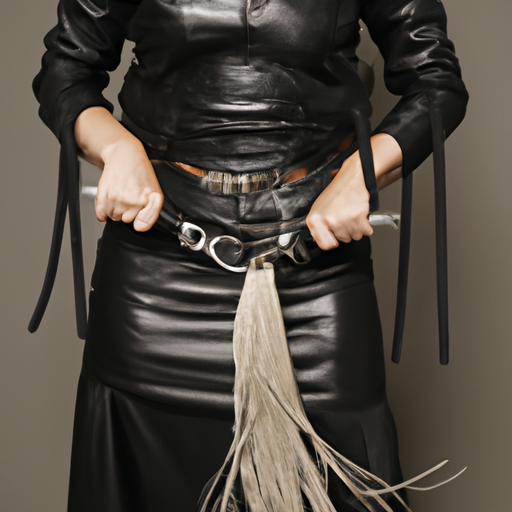In the realm of human sexuality, people often have unique desires and interests. One such interest is the concept of female dominance, commonly referred to as femdom. While femdom is a broad term that encompasses various dynamics, it is important to approach this topic with sensitivity and respect. In this blog post, we will explore the question: Are there any specific symbols or attire associated with real African femdom?

Before delving into the specific symbols and attire associated with African femdom, it is crucial to acknowledge that human sexuality and its manifestations are diverse and complex. What one individual finds arousing or pleasurable may not resonate with another. Therefore, it is vital to respect the boundaries, consent, and individual preferences of all parties involved.
When exploring the concept of African femdom, it is essential to recognize the rich cultural diversity of the African continent. Africa is home to numerous vibrant cultures, each with its own set of traditions, beliefs, and practices. The idea of femdom, as understood in Western contexts, may not align perfectly with traditional African cultures.
That being said, it is not uncommon for symbols and attire to play a role in various forms of dominance and submission, including femdom. In some African cultures, certain symbols or attire may hold significance in power dynamics or rituals related to dominance. However, it is crucial to approach these symbols and attire with cultural sensitivity, as they may have deeper cultural meanings beyond their association with femdom.
In some West African cultures, for instance, the use of traditional clothing and jewelry can convey power, authority, and dominance. Adornments such as elaborate headpieces, intricate body jewelry, and vibrant fabrics can be worn by individuals in positions of leadership or authority. While these elements may not be exclusive to femdom, they can contribute to a power dynamic within sexual or BDSM contexts.
It is important to note that the portrayal of African femdom in popular media and adult entertainment often perpetuates harmful stereotypes and fetishization. These portrayals can further perpetuate the exoticization and objectification of African cultures and individuals. It is crucial to approach these topics with cultural sensitivity and respect, always prioritizing consent and informed exploration.
Ultimately, the concept of femdom, including its potential African manifestations, is deeply personal and subjective. Each individual’s desires, preferences, and boundaries should be respected and celebrated. It is essential to engage in open and honest communication with partners to establish consent, negotiate boundaries, and explore shared interests in a safe and consensual manner.
In conclusion, while there may be symbols and attire associated with power dynamics and dominance within certain African cultures, it is important to approach this topic with cultural sensitivity and respect. It is crucial to prioritize consent, open communication, and the empowerment of all individuals involved. Ultimately, the exploration of femdom, or any other form of sexual expression, should be rooted in mutual understanding, consent, and a commitment to fostering healthy and respectful relationships. DominatrixCam.net.
How has the portrayal of Latina dominatrixes evolved in popular culture over the years?
The portrayal of latina dominatrixes in popular culture has undergone significant changes and evolution over the years. From the early days of cinema to the present, the depiction of these characters has shifted, reflecting societal attitudes and a broader understanding of diversity and representation. In this blog post, we will explore the historical context, examine notable examples, and discuss the impact of these changes.

Historically, portrayals of Latina dominatrixes were often limited and stereotypical. They tended to reinforce existing stereotypes, perpetuating an exoticized and hypersexualized image of Latina women. These characters were typically portrayed as seductive, aggressive, and in control, using their sexuality as a tool for dominance. Such portrayals often failed to capture the diversity and complexity of Latina identities.
However, as societal attitudes began to change and discussions around representation and diversity gained traction, the portrayal of Latina dominatrixes started to evolve. Filmmakers, writers, and artists began to challenge stereotypes and offer more nuanced and authentic depictions of these characters.
One significant shift in popular culture was the exploration of the intersectionality of Latina dominatrixes. Instead of being solely defined by their sexuality, these characters began to be portrayed as complex individuals with multifaceted identities. They were shown as having agency, ambition, and depth beyond their dominatrix persona. This shift allowed for a more realistic and inclusive representation of Latina women.
An example of this evolution can be seen in the 1992 film ‘The Mambo Kings.’ In this film, the character of Cesar Castillo, played by Armand Assante, encounters a Latina dominatrix named Maria Rivera, portrayed by actress Cote de Pablo. Unlike previous portrayals, Maria is depicted as a multi-dimensional character with her own desires, struggles, and aspirations. Her dominatrix persona is just one aspect of her complex identity, and the film explores her journey of self-discovery and empowerment.
Another notable example of the evolving portrayal of Latina dominatrixes is the character of Ana Lucia Cortez in the hit TV series ‘Lost.’ Played by actress Michelle Rodriguez, Ana Lucia breaks free from the traditional stereotypes associated with Latina dominatrixes. She is a strong, independent, and fiercely determined character, showcasing a more realistic and relatable representation of Latina women.
Furthermore, the rise of independent cinema and alternative media platforms has allowed for even more diverse and authentic portrayals of Latina dominatrixes. Filmmakers and content creators have been able to explore different narratives and perspectives, offering a more nuanced understanding of these characters. This has opened up opportunities for Latina actresses to play complex and fully realized dominatrix characters on screen.
In conclusion, the portrayal of Latina dominatrixes in popular culture has evolved significantly over the years. From stereotypical and one-dimensional characters, we have seen a shift towards more authentic and inclusive representations. This evolution reflects changing societal attitudes and a growing awareness of the need for diversity and accurate representation in media. As we continue to challenge stereotypes and strive for more inclusive storytelling, it is important to celebrate the progress made while also acknowledging the work that still needs to be done.